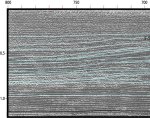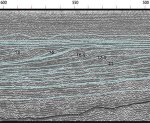 |
|
|
|||
|
Seismic
Sequence Analsis DISCUSSION The two 1990 core borings on the western margin of the Great Bahamas Bank have confirmed this interpretation. Interestingly, the seismic section suggests progradation of the bank margin continued at sea level lows even though the platform was exposed. It would appear that either in situ accumulation remained high at sea level lows or that the platform sediments were eroded. For a carbonate shelf setting with a low rate of subsidence and a high rate of sedimentation, very clear stratigraphic signals should be produced by eustatic sea level changes. This requires that the rate of carbonate sedimentation be such that the accommodation was filled to sea level, suggesting that the sediment surface on the shelf can be taken as a proxy of this sea level. For such a case, when 1) the rates of subsidence and carbonate accumulation were constant during several sea level cycle; and 2) there was a match in the frequency and amplitude of the onlapping geometries of seismic and simulation, then it can be assumed that the frequency and amplitude of eustatic events of the input curve, the corrected Neogene Curve (NC) used for this study, is close to reality. This match in the seismic and the simulation geometries established that ustatic sea level charts can be used to date seismic sequence boundaries, as was the case of the Neogene carbonate platform of the of Straits of Andros in Bahamas. It also shows that the sea level curve can be used to test seismic interpretations and update the ages of sequence boundaries when biostratigraphic data is poor. Try to match your interpretation with results of ODP leg 166 Preliminary reports. The ages of the OPD SSBs are based on biomarker species horizons and the use of interpolated sedimentation rates between them. One might argue that the mismatch is because the the Haq et chartal chart is inaccurate or that some events are not as global as was thought. On the other hand the mismatch may be produced by a tectonic signal mixed with a global sea level signal, producing leads and lags in the formation of sequence boundaries. However, the fact is that your interpretation and the other from ODP, should match closely, and in this case this is a compelling argument for this kind of interpretation for dating similar sections where biostratigraphy is poor. Click here for a solution and match the output with your interpretation. For a fuller description of this solution, click on Eberli et al (1994), Kendall et al (1998), and Sen and Kendall (1999). To gain access to the complete image containing the interpreted seismic section of the exercise, click on the appropriate image to download it in a series of images (each divided image can be printed on a regular 11" X 8.5" paper). |
|||
 The laterally stacked sequences of a seismic section are the product
of tectonic movement and carbonate accumulation and also of sea
level
The laterally stacked sequences of a seismic section are the product
of tectonic movement and carbonate accumulation and also of sea
level



